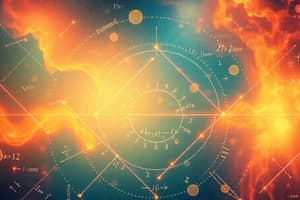Podcast
Questions and Answers
Déterminer l'intervalle de définition de g. (Référez-vous au tableau et graphique fournis)
Déterminer l'intervalle de définition de g. (Référez-vous au tableau et graphique fournis)
[-1, 5]
Donner les antécédents de 0 par la fonction g. (Référez-vous au tableau et graphique fournis)
Donner les antécédents de 0 par la fonction g. (Référez-vous au tableau et graphique fournis)
0, 2, 4
Donner les images des réels (-1) et 3 par la fonction g. (Référez-vous au tableau et graphique fournis)
Donner les images des réels (-1) et 3 par la fonction g. (Référez-vous au tableau et graphique fournis)
g(-1) = 3 et g(3) = -1
Décrire les variations de la fonction g sur son intervalle de définition. (Référez-vous au tableau et graphique fournis)
Décrire les variations de la fonction g sur son intervalle de définition. (Référez-vous au tableau et graphique fournis)
Résoudre les équations a) g(x) = 3 et b) g(x) = -1. (Référez-vous au tableau et graphique fournis)
Résoudre les équations a) g(x) = 3 et b) g(x) = -1. (Référez-vous au tableau et graphique fournis)
Préciser, si possible, le minimum et le maximum de g sur son intervalle de définition. (Référez-vous au tableau et graphique fournis)
Préciser, si possible, le minimum et le maximum de g sur son intervalle de définition. (Référez-vous au tableau et graphique fournis)
Résoudre l'inéquation g(x) ≤ 0. (Référez-vous au tableau et graphique fournis)
Résoudre l'inéquation g(x) ≤ 0. (Référez-vous au tableau et graphique fournis)
On considère les points A(-2; 1), B(-1; 3), C(3; 1), D(2; -1). Démontrer les coordonnées du point M milieu du segment [AC].
On considère les points A(-2; 1), B(-1; 3), C(3; 1), D(2; -1). Démontrer les coordonnées du point M milieu du segment [AC].
On considère les points A(-2; 1), B(-1; 3), C(3; 1), D(2; -1). Calculer le produit scalaire $\vec{AB} \cdot \vec{AD}$ et en déduire la nature du triangle ABD.
On considère les points A(-2; 1), B(-1; 3), C(3; 1), D(2; -1). Calculer le produit scalaire $\vec{AB} \cdot \vec{AD}$ et en déduire la nature du triangle ABD.
On considère les points A(-2; 1), B(-1; 3), C(3; 1), D(2; -1). Calculer les distances DB et AC. Démontrer si AC et BD sont perpendiculaires ou non.
On considère les points A(-2; 1), B(-1; 3), C(3; 1), D(2; -1). Calculer les distances DB et AC. Démontrer si AC et BD sont perpendiculaires ou non.
On considère les points A(-2; 1), B(-1; 3). Donner l'équation cartésienne de la droite (AB).
On considère les points A(-2; 1), B(-1; 3). Donner l'équation cartésienne de la droite (AB).
On considère les points C(3; 1), D(2; -1). Donner une représentation paramétrique de la droite (DC).
On considère les points C(3; 1), D(2; -1). Donner une représentation paramétrique de la droite (DC).
On considère les points A(-2; 1), C(3; 1). Déterminer l'équation du cercle $(\mathcal{C})$ de diamètre [AC].
On considère les points A(-2; 1), C(3; 1). Déterminer l'équation du cercle $(\mathcal{C})$ de diamètre [AC].
Flashcards
Domain of g(x)
Domain of g(x)
The domain of a function g(x) is the set of all possible input values (x-values) for which the function is defined.
Frequency (f)
Frequency (f)
The frequency 'f' is the number of times a vibration repeats itself in a certain time, for example, measured in Hz.
Zeros of g(x)
Zeros of g(x)
Zeros are the x-values where the function equals 0 at g(x) = 0.
Range of g(x)
Range of g(x)
Signup and view all the flashcards
Function Period
Function Period
Signup and view all the flashcards
Study Notes
- The image includes a table and questions related to functions and their properties.
- The table shows values of a function and its associated graph.
- The questions require identifying the domain, range, zeros, and intervals of increase or decrease of the function, as well as finding its approximate values and limits.
Exercise #1
- Determine the domain of the function g.
- Determine the image of g(x) = 0
- How many zeros does g have?
- Indicate the intervals in which g increases or decreases.
- Determine if −1 ∈ g(−1; 1)
- Approximate: g(-1) = x
- Approximate: Lim x->-1 g(x) = x
- Trace the curve approximated by g if it continues indefinitely.
Exercise #2
- Given the implicit function, consider the order pairs: A(-1, -1), B(2,3), C(-1/2, 0), D(1.5, -1/2)
- Plot it on a plane
- Determine the conditions of the point M(x,y) ∈ AB + AC if x < 1
- Determine the product between AB + AC and the slope of the line
- Determine if vector AB is perpendicular to vector AC
- Determine the parametric equations of the line L
- Approximate: g(-1) = x
- Determine if vectors MA and AB are dependent.
Studying That Suits You
Use AI to generate personalized quizzes and flashcards to suit your learning preferences.




